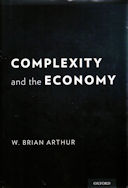This slim but densely-packed important book is a joy to read.
Technology is a crucial feature of our lives, and the genesis of
certain individual artefacts are well-studied, yet technology as a
whole is little studied. Arthur sets out to discover just what
technology is, and how it changes.
He gives three definitions of technology, covering three different
scales (p28): technology-singular, a means
to fulfil a human purpose, where the means is a device,
method or process; technology-plural, an assemblage
of practices and components; and technology-general, the
entire collection of devices and
engineering practices available to a culture. The book is
about examining these definitions, and examining how technology
changes at each of these scales.
Technology does not exist in isolation from the physical world: it
crucially comprises artefacts that harness natural phenomena. Those
phenomena themselves need technology in order to be harnessed,
particularly the more "advanced" ones.
p22.
Technology builds out not just from
combination of what exists already but from the constant capturing and
harnessing of natural phenomena. At the very start of technological
time, we directly picked up and used phenomena: the heat of fire, the
sharpness of flaked obsidian, the momentum of stone in motion. All
that we have achieved since comes from harnessing these and other
phenomena, and combining the pieces that result.
He considers mainly physical phenomena in the natural world. He
later touches on, but not in much depth, more abstract phenomena of
mathematics, information, and computation.
Once technology has started, it can bootstrap by combining
components in many ways, to fulfil more and more human purposes (some
of which are themselves created by technology). And as we get more
technologies, we can combine them in more ways. Soon the potential
combinations outnumber the base components.
p25.
Modern technology is not just a
collection of more or less independent means of production. Rather it
is becoming an open language for the creation of structures and
functions in the economy. Slowly, at a pace measured in decades, we
are shifting from technologies that produced fixed physical outputs to
technologies whose main character is that they can be combined and
configured endlessly for fresh purposes.
Once combinations outnumber components, we are in the realm of
infrastructure, where the technology can be used in ways never
intended, or foreseen, by its inventors.
p31.
A technology embodies a sequence of
operations; we can call this its "software." And these
operations require physical equipment to execute them; we can call
this the technology's "hardware." If we emphasize the "software"
we see a process or method. If we emphasize the "hardware,"
we see a physical device.
I am going to stop including quotations at this point. The whole
book is so rich with ideas and illustrations that I would end up
quoting a large proportion of it. Just read the whole thing.
The trip through technology-singular, -plural, and -general is
fascinating, and should be required reading for anyone with an
interest in living in modern society. Towards the end, where Arthur is
considering technology-general, and how its ever-changing nature generates
a necessarily ever-changing economy, is particularly important today,
when governments seem to be hell-bent on restoring some non-existent
equilibrium state after the recent economic collapse. His description
of "deep craft", and why technologies cluster in
geographical locations, is important for people interested in "technology
transfer" (short answer: it's really difficult). And his comments
on the need for a fundamental science base to provide the seeds of the
next generation technology and deep craft are a crucial message for
today's short-termist, make everything have a return in the next
quarter, policy makers (not that they will listen).


